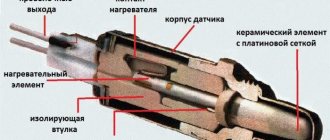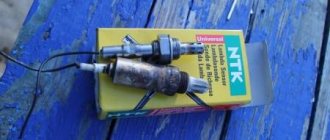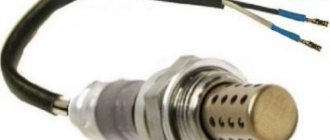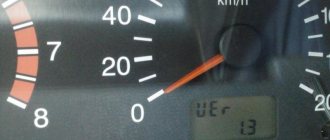The P0135 code is often diagnosed on cars. It stands for malfunction of the oxygen sensor heating circuit (bank 1, sensor 1). The numbering indicates that this sensor is installed before the neutralizer, that is, it is subject to greater heating.
Many car enthusiasts rush to replace an expensive lambda probe when error code P0135 appears. It's not always rational. The cause of the malfunction may be damage to the contacts or wiring.
The need to warm up the oxygen sensor
To start working, the oxygen sensor requires the sensing element to be heated to a certain temperature.
During engine operation, this is ensured by the temperature of the exhaust gases, especially on modern engines with catalytic collectors, where the upper lambda probe is installed close to the cylinder head. Initially, lambda probes did not have any heating circuits - you can encounter such sensors, for example, on old “Japanese” ones (single-wire, where the signal “ground” goes through the exhaust pipe to the engine, and more accurate two-wire ones with a separate signal “ground”). At a time when the severity of environmental standards was incomparable to today, the lack of correction by the lambda probe during engine warm-up was not critical: the engine warmed up with a knowingly rich mixture. Already as the signal at the output of the lambda probe began to change, the electronic control unit (ECU) switched to an algorithm, including feedback from the oxygen sensor.
Subsequently, environmentalists paid close attention to this regime. Automakers had to ensure that the injection system was brought to a “closed loop” as quickly as possible in order to meet the requirements of environmental standards. This is how heated oxygen sensors appeared, first wire, and then ceramic.
As soon as you turn on the ignition, the injection ECU carries out an initial test of itself and peripheral circuits, including the heating of the oxygen sensor. By the time the engine starts, it has already warmed up, finally reaching operating mode with minimal delay. But this also arose the possibility of an “extra” malfunction.
Monitoring the integrity of the heater occurs in the ECU very simply - by the voltage drop across a resistor of very low resistance (hundredths of an ohm) connected to the circuit of the transistor that controls the heating. When everything is normal, in full accordance with Ohm's law for the complete circuit, there is a small voltage on this transistor, which is regarded by the ECU controller as normal operation of the heater. But if there is too much resistance in the circuit BEFORE this resistor or its complete break, the voltage across the measuring resistor becomes zero. The controller, having detected this, goes into emergency mode and stores error P0135.
Symptoms of error P0135
There are no obvious symptoms that would indicate a malfunction of the oxygen sensor heating circuit. As with any other error, when trouble number P0135 occurs, the “Check Engine” light will come on, which recommends that the vehicle owner contact a service center to find out the specific cause of the malfunction.
This is interesting: How much oil should be poured into the VAZ 2107 engine?
Among the indirect manifestations of error P0135, the driver may notice a problem with increased fuel consumption. But the problem here is that the increase in fuel is so insignificant that many do not even notice due to the “ragged” driving mode.
A couple more symptoms of the P0135 error are a loss of dynamics when accelerating, a change in the exhaust sound (to a “heavier” or “harassing”) and a change in the exhaust smell, which can also be felt in the cabin, to a more pungent one.
Please note: The symptoms of the P0135 error are largely determined by the settings of the electronic control unit, which is responsible for engine operation.
Codes related to P0141
- P0030 - DC heater control circuit, bank 1, sensor 1.
- P0036 - DC heater control circuit, bank 1, sensor 2.
- P0053 - DC heater resistance, bank 1, sensor 1.
- P0054 - DC heater resistance, bank 1, sensor 2.
- P0135 - DC heater performance, bank 1, sensor 1.
- P0141 - DC heater performance, bank 1, sensor 2.
- P0050 - DC heater control circuit, bank 2, sensor 1.
- P0056 - DC heater control circuit, bank 2, sensor 2.
- P0059 - DC heater resistance, bank 2, sensor 1.
- P0060 - DC heater resistance, bank 2, sensor 2.
- P0155 - DC heater performance, bank 2, sensor 1.
- P0161 - DC heater performance, bank 2, sensor 2.
Causes of error P0135
In order for error P0135 to be recorded in the computer memory, and for the driver to see the message “Check engine”, it is necessary that the temperature of the converter be higher than optimal, and at the same time, the resistance of the oxygen sensor must be higher.
It is important to note that even if error P0135 is eliminated, its code is recorded in memory. Accordingly, during the next diagnosis it will be displayed, even if the problem itself has already been neutralized.
Please note: If you are in doubt about the presence of a P0135 error in your vehicle, you should use the test mode, not the self-diagnosis mode. In this case, the records in the archive must be reset.
The P0135 error itself is indicated by problems with the oxygen sensor heater. This error can be caused by a limited number of problems:
- Problems with the operation of the oxygen sensor itself. For example, it may fail;
- Faulty contact supplying the oxygen sensor. For example, it may be oxidized;
- Short circuit in the circuit or broken wiring.
Please note: In rare situations, other problems may cause P0135. For example, failures in the car's ECU itself. But this happens so rarely that it is not considered within the scope of this article.
To resolve error P0135, you need to understand what specifically causes it, and then solve the problem.
Common reasons
The main reason for the appearance of error P0135 is an open circuit in the heater circuit of the working element of the oxygen sensor (OS). It can happen:
- due to wear and tear of the DC;
- when the on-board network voltage is increased due to a generator malfunction;
- due to mechanical damage to the DC and connector;
- due to a violation of the tightness of the structure.
Structurally, the recreation center looks as shown in the figure.
The electric oxygen sensor heater can be made of a carbon element or nichrome wire. In the first case, the DC is more sensitive to increased mechanical loads. The heating element may fail during dismantling and installation. During operation, the heater has a temperature of up to 350 degrees Celsius. The presence of microcracks in the DC body leads to its oxidation and destruction. The service life of the heating element is usually between 5 and 10 years.
Video - if error code P0135 is shown during diagnostics, what nuances may there be (using the example of Nissan X-Trail NT30):
Diagnosis of the problem
The most common problem that causes P0135 on vehicles with a low oxygen sensor is a physical break in the wire. You don’t have to be into off-road driving to do this: you can damage the wiring even in an off-road parking lot if you’re unlucky. Therefore, first of all, inspect both the sensor wiring and its connector. We are specifically interested in the heating wires, which can be found in the service documentation for your car or, in the case of common Bosch sensors, immediately look at the two white wires.
Something else useful for you:
- Why does the engine start poorly when cold?
- Fuel pressure regulator - device, principle of operation, malfunctions
- Why does the speed fluctuate on a cold engine?
If there are no visible signs of a break or oxidation of the wiring (do not forget that an excessive increase in circuit resistance will also lead to error P0135!), measure the resistance of the heater with a tester. Depending on the model of a particular lambda probe, it varies, but in any case it will be in the range of 3-20 Ohms.
If the measured value differs by an order of magnitude, or the tester shows a complete break, the sensor must be replaced. Usually the ceramic heating element fails due to cracking (often a rustling sound is heard in the removed sensor when shaken), but in any case it is not repairable.
This is interesting: Self-replacement of valve stem seals on a VAZ 2109 - tips and recommendations
But, if the resistance of the heater itself is normal, the problem lies in the external circuits. Having turned on the ignition, we use a tester to check the contacts on the “braid” connector. On one of them, the voltage differs slightly from the on-board voltage, the second is called to ground (the heating control key is open, the resistance of the open key is tenths or hundredths of an ohm).
The biggest problem is the failure of the key itself in the control unit, which is rare, but even in diagnostic practice one has to deal with it. In this case, the most profitable option for the owner, even for domestic cars, is to resolder the block rather than replace it with a new one. To check the serviceability of the key, use a tester to test the entire circuit from the lambda probe connector to the injection computer connector. If the circuit is working properly, it is the block that is “to blame”.
Signs of error P0135
Even before diagnosing the P0135 error, the following symptoms may indicate its possible presence:
- complicated engine starting, especially in the cold season, wet weather;
- change in the nature of exhaust gases (grayish-black tint);
- slightly increased fuel consumption per unit of travel.
The listed symptoms may be the result of other malfunctions, therefore, to accurately determine the type of error, computer diagnostics of the engine should be performed.
On which cars is this problem most common?
The problem with code P0141 can occur on different machines, but there are always statistics on which brands this error occurs more often. Here is a list of some of them:
- Acura
- Alfa Romeo
- Audi
- BMW
- Chevrolet (Chevrolet Aveo, Cavalier, Captiva, Cruz, Lanos, Lacetti, Orlando, Epica)
- Chrysler
- Citroen (Citroen C4, C5)
- Daewoo (Daewoo Matiz, Nexia)
- Dodge (Dodge Caravan)
- Fiat (Fiat Albea, Punto, Stilo)
- Ford (Ford Maverick, Mondeo, Focus, Escape)
- Geely (Geely MK)
- Honda (Honda Accord, SRV, Stream, Civic, HR-V)
- Hover
- Hyundai (Hyundai Accent, Getz, Santa Fe, Sonata)
- Kia (Kia Rio, Sorento, Spectra, Sportage)
- Lexus (Lexus gs300, rx300)
- Lifan (Lifan Solano)
- Mazda (Mazda Millenia, Tribute)
- Mercedes (Mercedes w203, w210)
- Mitsubishi (Mitsubishi Outlander, Galant, Karisma, Colt, Lancer, Montero, Pajero)
- Nissan (Nissan Almera, Qashqai, Maxima, X-Trail)
- Opel (Opel Astra, Vectra, Zafira, Corsa, Meriva, Omega)
- Peugeot (Peugeot 107, 206, 207, 307, 308, 406, 407)
- Renault (Renault Duster, Laguna, Logan, Megan, Sandero, Scenic, Fluence)
- Skoda (Skoda Fabia)
- Subaru
- Suzuki (Suzuki Grand Vitara, Liana)
- Toyota (Toyota Avensis, Camry, Corolla, Rav4, Highlander, Harrier, Yaris)
- Volkswagen (Volkswagen Golf, Passat)
- Volvo
- Gazelle Business, Next, umz 4216
- Zaz Chance
- Lada Kalina, Largus, Niva, Priora
- UAZ
With fault code P0141, you can sometimes encounter other errors. The most common ones are: P0036, P0130, P0132, P0135, P0136, P0138, P0155, P0161, P0171, P0174, P0300, P0301, P0302, P0303, P0304, P0314, P0400, P0443, P1409.
What to do if P0135 occurs
Error P0135, if it occurs alone, can be resolved quite simply. As you can see, there are quite a few reasons for its occurrence. We recommend following the following algorithm to fix error P0135:
- The first thing you need to do is make sure that the sensor itself is working. The surest way to do this is to install a new sensor and check for an error. If this is not possible, go to the second point;
- Check the oxygen sensor contact. Even if it seems normal, it is better to clean it of possible oxides for diagnostic purposes;
- Next, diagnose the heating resistance of the oxygen sensor. With a warm engine at an average ambient temperature (about 15-20 degrees Celsius), the resistance between two wires of the same color that matches the sensor should be about 3-9 ohms (depending on the car model). If there is no resistance or it is significantly greater than recommended, this may indicate an open circuit or short circuit.
If you have checked all of the above points except the first and found no problems, this indicates a malfunction of the sensor itself. In this case, it needs to be replaced, since oxygen sensors are not economically feasible to repair.
How to check?
Since there are not many causes of problems, many do not waste time checking the lambda probe, but immediately replace it. This method is especially often used in car services. If you are repairing your car, it is worth first inspecting, checking the contacts and other signs of malfunction of the lambda probe before purchasing a new sensor.
To check, you will need an inspection hole, since this sensor is located behind the catalyst.
When you remove the power connector, you will almost certainly see that the contact is covered with oxidized green metal. At the same stage, it is worth checking the wires coming from the connector. One of them may be broken or cause a short circuit. After this, you need to take a multimeter and check the resistance of the heater winding.
In this case, it is extremely important to know what the nominal resistance of your car model should be. At room temperature, the resistance, by definition, will be less than when the engine warms up to several hundred degrees.
Is it possible to drive with P0135?
Older injection systems initially retain a “wait” for warming up, that is, in the worst case, fuel consumption will slightly increase (due to the fact that reaching the “closed loop” during warming up will begin to lag). Many cars easily drive several thousand until the owner gets tired of the Check Engine light being on.
This is interesting: Typical thermostat malfunctions and replacement on a 406 divigator
In the future, this emergency algorithm was preserved, the only “but” in the larger “choke” under strict economic standards. That is, a modern car will not experience serious problems with faulty heating if the sensor itself is working properly.
However, if the error occurs randomly (that is, after a reset, not immediately after turning on the ignition, when the self-test is running, but with a random delay or even while driving), then this indicates more serious problems. Thus, there are known cases when, to eliminate error P0135, dealers replaced defective wiring harnesses on Kia Ceed. If the error occurs due to a bad contact on the ECU connector, then it is unlikely that the problem is only in one contact out of several dozen (or even more than a hundred), there may be further “surprises”.
Therefore, the answer is simple: you can drive with a faulty heated upstream oxygen sensor. But with error P0135 without establishing the exact cause of its occurrence, it is extremely undesirable.
How is error P0130 diagnosed?
For P0130 to be stored in the vehicle's ECU, the oxygen sensor must be faulty for 1 minute or more. If no data is received from the sensor (or it is erroneous, for example, the lambda probe slowly changes values) for a minute, then error information P0130 is stored in memory.
It is worth noting that if the oxygen sensor fails and no signal is received from it, error P0134 can be diagnosed along with error P0130.
Possible consequences of error P0135
It is wrong to believe that the consequences of failure of the heating element of the oxygen sensor are as significant as those of the lambda probe as a whole. It is known that if the lambda probe is inoperative, fuel consumption and exhaust gas toxicity significantly increase.
Initially, oxygen sensors had no heating elements at all. The operating efficiency of the DC depends on the heating temperature of the control zone. Correct operation of the DC is ensured if the ceramic element is heated to a temperature of about 300 degrees Celsius. During initial engine startup, the DC is cooled and its temperature is close to ambient temperature. Thus, until the exhaust gases warm up the sensor, its readings are incorrect. This leads to increased fuel consumption, the formation of an incorrect fuel/air mixture, and increased toxicity of exhaust gases in the first five to ten minutes after starting the power unit.
In urban vehicle operation over short distances, the warm-up time can be comparable to the total driving time. To prevent the harmful consequences of driving on an unheated vehicle with incorrect readings, experts proposed forced heating of the oxygen sensor. Thus, if the machine is operated over long distances, the consequences of an open oxygen sensor heating circuit are minimized.
How to avoid mistakes during troubleshooting
In order to save money and accurately establish the “diagnosis”, follow these simple tips:
- Check the wiring and sensor connector for moisture, which may cause a short circuit.
- Check the lambda probe for oil or coolant contamination.
- After installing the new oxygen sensor, check it with a scan tool to ensure that the heater circuit is working properly.
- Check the old lambda probe for damage caused by a faulty catalytic converter.
Finding a Possible Fault in the Oxygen Sensor Heat Circuit
In order to determine the specific location of the circuit break when error P0135 appears, you should check the resistance of the circuit sections. First of all, check the resistance of the oxygen sensor heating circuit. To do this, you need to know the pinout diagram of the lambda probe connector. The probes of a multimeter switched to resistance measurement mode at a limit of 200 Ohms are connected to the terminals connected to the heater circuit.
The resistance should be several ohms, in this case 12.7 ohms. You can check the DC by current consumption. It is usually from 1 to 3 Amps. If there is a break in the circuit, that is, the multimeter shows infinity (on Chinese multimeters - 1 in upper case), then you should check the cable going to the sensor. It can be damaged as it is located near the very hot exhaust manifold.
If the oxygen sensor circuit is called using a multimeter, you need to check the power supply to the heating circuit:
1. Check for grounding on the common wire going to the DC. This operation can be performed without starting the engine.
2. Check the supply of +12V supply voltage to the output of the heating circuit with the engine running. If voltage is not supplied, it is necessary to check the fuse that serves the DC, according to the diagram. It is also possible that the relay in the heating activation circuit may be damaged.
3. If the previous steps did not work, you need to temporarily connect the oxygen sensor heating power directly. To do this, it is better to dismantle it from the installation site before doing this. As in glow plugs, the DC can ring when cold, but when it is heated, the geometric dimensions increase and the circuit opens. The sensor will first warm up, then cool down. In this case, the lambda probe must be replaced.










